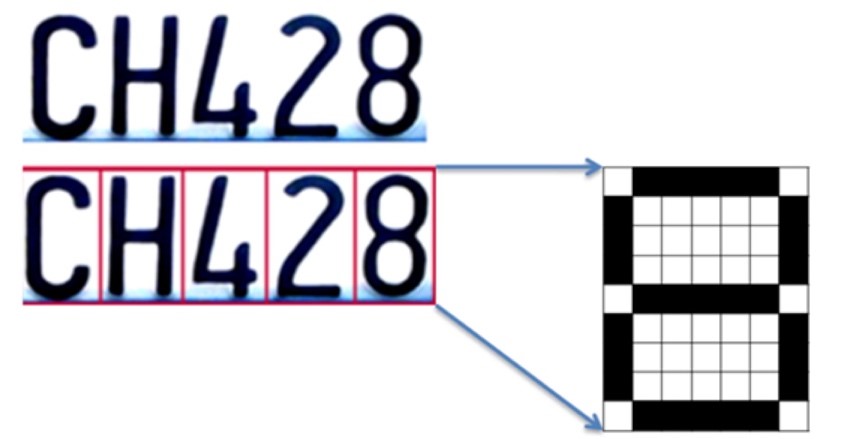- Illuminate new insights
- Reduce information overload
- Elevate analysts
 A visual representation of an automatic plate number recognition system[/caption]
Today, more advanced machine learning technologies provide us with automated methods of generating insights from raw data:
A visual representation of an automatic plate number recognition system[/caption]
Today, more advanced machine learning technologies provide us with automated methods of generating insights from raw data:
- Google’s open source machine learning library TensorFlow enables the creation of new software models that can automatically detect objects in images (e.g., find all of the street signs in a photo).
- Collaborating with CosmiQ Works and NVIDIA, DigitalGlobe issued the SpaceNet Challenge to encourage the creation of machine learning models that can automatically detect building footprints and other objects in satellite imagery.
- Using natural language-processing technologies like Python NLTK and SpaCy, computers can detect the positive or negative sentiment of a social media post.
- DigitalGlobe’s Geospatial Big Data platform (GBDX) provides analysts with the ability to run automated object detection algorithms against petabytes of data with point and click simplicity.
 In a talk at GEOINT 2017, I provided some specific ideas on how intelligent automation will accelerate analysts’ workflow in the future.
Elevating Analysts
The Marvel comic “Iron Man” tells the fictional story of Tony Stark. Tony Stark is an eccentric engineer who creates an armored suit that provides the ability to fly and wield directed energy weapons. The Iron Man suit also has a resident Artificial Intelligence (AI) virtual assistant named Jarvis that provides critical co-piloting and information delivery functions.
In a talk at GEOINT 2017, I provided some specific ideas on how intelligent automation will accelerate analysts’ workflow in the future.
Elevating Analysts
The Marvel comic “Iron Man” tells the fictional story of Tony Stark. Tony Stark is an eccentric engineer who creates an armored suit that provides the ability to fly and wield directed energy weapons. The Iron Man suit also has a resident Artificial Intelligence (AI) virtual assistant named Jarvis that provides critical co-piloting and information delivery functions.
 Although fully human, Stark has superpowers he uses to support the band of heroes known as the Avengers. His advanced robotic suit and AI assistant enable him to perform tasks that he would have been unable to perform without technological enhancement.
The future of information analysis is not android robots or autonomous algorithms detached from humans. It is not merely faster CPUs and bigger RAM chips. The future of analysis is human analysts empowered and supported with automation technologies that allow them to address bigger challenges than ever before.
As Robert Cardillo said at GEOINT 2017, automation is a “transforming opportunity for the profession” of intelligence analysts. “Automation isn’t there to get rid of you; it’s there to elevate you. It’s about giving you a higher-level role to do the harder things.”
Although fully human, Stark has superpowers he uses to support the band of heroes known as the Avengers. His advanced robotic suit and AI assistant enable him to perform tasks that he would have been unable to perform without technological enhancement.
The future of information analysis is not android robots or autonomous algorithms detached from humans. It is not merely faster CPUs and bigger RAM chips. The future of analysis is human analysts empowered and supported with automation technologies that allow them to address bigger challenges than ever before.
As Robert Cardillo said at GEOINT 2017, automation is a “transforming opportunity for the profession” of intelligence analysts. “Automation isn’t there to get rid of you; it’s there to elevate you. It’s about giving you a higher-level role to do the harder things.”